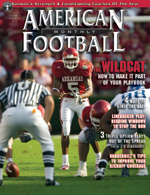AMERICAN FOOTBALL MONTHLY THE #1 RESOURCE FOR FOOTBALL COACHES
|
|
Article Categories
|
Speed Report: Natural Speed or Team Speed - Find It Or Produce It?by: Dale BaskettFootball Speed Specialist© More from this issueWhen engaged with a large number of athletes, you always find certain kids who have decent speed. On the other hand, most in the group are not blessed with natural speed.
Team speed is sometimes indigenous to areas that have larger populations; that is, strength in numbers to pick from as a whole. Producing speed is vital for most programs and should be the quest for every program that’s interested in competing at a high level. Weight training has long been a significantly large part of, or at least thought of as profoundly responsible, for speed development.
Interestingly enough, I placed a speed test series of questions in the magazine recently. I asked a question about weights being heavily responsible by percentage for speed gain. The majority, two thirds or so, answered true. The answer is false. Fifteen y....The full article can only be seen by subscribers.
Subscribe today!

|
|
|
NOT A SUBSCRIBER?
Subscribe
now to start receiving our monthly magazine PLUS get INSTANT
unlimited access to over 4000 pages of 100 percent football coaching
information, ONLY available at AmericanFootballMonthly.com!
|
|
|
HOME
|
MAGAZINE
|
SUBSCRIBE
|
ONLINE COLUMNISTS
|
COACHING VIDEOS
|
Copyright 2026, AmericanFootballMonthly.com
All Rights Reserved






